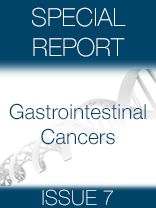Panitumumab Boosts Overall Survival in Chemorefractory mCRC
Complimenting best supporting care with panitumumab dropped the risk of death by 30% for patients with RAS wild-type chemorefractory metastatic colorectal cancer (mCRC).
1
In the open-label phase III study, which was presented at the 2016 Gastrointestinal Cancers Symposium, patients exhibited a median overall survival (OS) of 10.0 months with panitumumab compared with 6.9 months with best supportive care alone for those withRASwild-type mCRC (HR, 0.70; 95% CI, 0.53-0.93;P= .0135). In those patients withKRASwild-type tumors, median OS was 10.0 months in the panitumumab arm compared with 7.4 months with best supportive care alone (HR, 0.73; 95% CI, 0.57-0.93;P= .0096).
“Panitumumab significantly improved OS in chemorefractory wild-type KRAS exon 2 mCRC,” Tae Won Kim, MD, University of Ulsan College of Medicine, Seoul, South Korea, and colleagues wrote in their abstract. “The treatment effects in OS and progression-free survival were more pronounced in those with wild-type RAS mCRC, further substantiating the importance of RAS testing at diagnosis to best inform the use of panitumumab to treat mCRC.”
In the study, 377 patients were randomized in a 1:1 ratio to receive 6 mg/kg of panitumumab every 2 weeks plus best supportive care (n = 189) or best supportive care alone (n = 188). The primary endpoint of the study was OS, with secondary outcome measures focused on progression-free survival (PFS), objective response rate (ORR), and safety. Crossover in the study was not permitted.
All patients in the study had progressed or were intolerant to prior treatment with irinotecan and oxaliplatin. Additionally, patients had received prior treatment with a thymidylate synthase inhibitor. Patients treated with a prior anti-EGFR antibody and those with symptomatic brain metastases were excluded from the study.
KRAS alterations were specific to exon 2 while RAS mutations were detected in exons 2, 3, and 4 of KRAS and NRAS. All patients enrolled were KRAS wild-type, with 86% also testing as wild-type for RAS (n = 270). In the 14% of patients with RAS-mutated mCRC (n = 54), the addition of panitumumab did not show an OS improvement versus best supportive care (HR, 0.99; 95% CI, 0.49-2.00).
In the full KRAS wild-type population, median PFS was 3.6 versus 1.7 months with and without panitumumab, respectively (HR, 0.51; 95% CI, 0.41-0.64;P<.0001). The ORR was 27% with panitumumab versus 1.6% with supportive care (odds ratio [OR], 24.9; 95% CI, 7.5-123.8;P<.0001).
In those with RAS wild-type mCRC, median PFS was 5.2 months with panitumumab versus 1.7 months with supportive care (HR, 0.46; 95% CI, 0.35-0.59;P<.0001). The ORR with panitumumab was 31% compared with 2.3% with supportive care (OR, 20.0; 95% CI, 5.9-101.6;P<.0001).
Overall, adverse events in the study were consistent with previous reports for panitumumab. In general, the fully human anti-EGFR antibody is associated with dermatologic toxicity in 90% of patients. The most common dermatologic adverse events are acneiform dermatitis, pruritus, erythema, rash, skin exfoliation, paronychia, dry skin, and skin fissures.
“Amgen is committed to understanding cancer biology through studies like this,” Sean E. Harper, MD, executive vice president of Research and Development at Amgen, said in a statement. “As well as providing additional insights into the way Vectibix works in mCRC, these data support expanding biomarker screening to include wild-type RAS.”
Panitumumab was initially approved as a treatment for patients with mCRC in September 2006. Since that time, the label has undergone various revisions and changes, along with approvals for new indications.
In May 2014, panitumumab was approved in combination with FOLFOX as a frontline treatment for patients with KRAS wild-type mCRC. In early March 2015, the FDA revised the panitumumab label further to be specifically indicated for the treatment of patients with RAS wild-type mCRC.
In a biomarker analysis of the phase III PRIME study that was published in the New England Journal of Medicine,2narrowing down treatment with panitumumab to patients with wild-type RAS resulted in an improvement in OS of 5.8 months. Median OS with panitumumab plus FOLFOX4 was 26.0 months compared with 20.2 months with FOLFOX4 alone in patients with wild-type RAS mCRC (HR, 0.78;P= .04).
The PRIME study was followed by a number of retrospective analyses exploring RAS as a biomarker for EGFR-targeted therapy. The phase III study presented at the GI Cancers Symposium was the first prospective analysis to assess efficacy in both RAS and KRAS wild-type tumors, further solidifying a continued shift toward an expanded testing strategy.
References
- Kim TW, Elme A, Kusic Z, et al. An open label, randomized phase III trial evaluating the treatment (tx) effects of panitumumab (pmab) + best supportive care (BSC) versus BSC in chemorefractory wild-type (WT) KRAS exon 2 metastatic colorectal cancer (mCRC) and in WT RAS mCRC.J Clin Oncol. 2016;34 (suppl 4S; abstr 642).
- Douillar J-Y, Oliner KS, Siena S, et al. PanitumumabFOLFOX4 Treatment and RAS Mutations in Colorectal Cancer.N Engl J Med. 2013;369:1023-1034.
